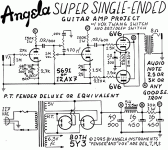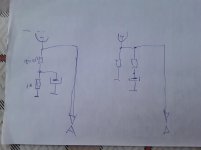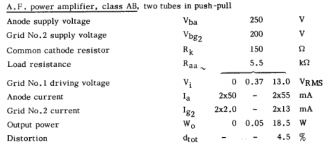I thought your designation of SSE must stand for Stereo Single Ended and that this thread was about building a stereo amp, not a guitar amp.
Thank you for replying... SSE can mean stereo single ended but what about super single ended by Angela... I will post a schematic. Thanks for minding and correcting me.
Attachments
Thanks for minding that one... Yeah i did not notice the negative feedback is not connected properly, that is because I was in a rush and i draw what came to mind pretty quickly (pretty wrong from my point), I will post a new schematic of feedback. View attachment 622764
Still wrong.
Thanks for the clarification. Just to let you know, the moderators will likely move this thread over to the Instruments and Amps forum where I see you've also posted. Unlike some boards (like Audio Asylum and Audio Karma) they like to keep tube stereo and instrument amps separate on here. Most people on this forum are probably not familiar with the Angela schematic. I don't think I've ever seen it discussed on a guitar amp forum either, actually, so I guess it's not real common.
If all you have is SE output transformers and want more power it is an alternative approach if your OTs have the right primary impedance for the tubes you're using. A more common approach would be to use a different tube that puts out more power rather than running a pair in parallel.
If all you have is SE output transformers and want more power it is an alternative approach if your OTs have the right primary impedance for the tubes you're using. A more common approach would be to use a different tube that puts out more power rather than running a pair in parallel.
Last edited:
As was pointed out above, the EL86 only needs 200v on the plate so if you are using that tube you don't really need a power transformer that can put out 270-285v as you mentioned in your other thread. That would seem to be a good thing since maybe you can use a PT you already have. I know guitar amps often run tubes pretty hard but you can adjust the cathode resistor to vary the plate dissipation if necessary. Although, if your budget is limited you might not want to run them so hard that their life is limited.
Also, if you run them in parallel, the correct OT primary impedance would be 1.25k. Do you have an OT with that spec? It seems pretty low and not a common value, in my experience.
You might consider building a simpler, standard SE amp, not PSE (parallel single-ended) and just use a more efficient speaker. Remember, doubling the wattage of the amp only increases the speaker output by 3db, which is perceived as just slightly louder. You can arrive at the same perceived volume by just using a speaker that's 3db more efficient.
Also, if you run them in parallel, the correct OT primary impedance would be 1.25k. Do you have an OT with that spec? It seems pretty low and not a common value, in my experience.
You might consider building a simpler, standard SE amp, not PSE (parallel single-ended) and just use a more efficient speaker. Remember, doubling the wattage of the amp only increases the speaker output by 3db, which is perceived as just slightly louder. You can arrive at the same perceived volume by just using a speaker that's 3db more efficient.
A more common approach would be to use a different tube that puts out more power rather than running a pair in parallel.
I know... thanks for minding that one, but i have a pair of Mullard EL86 that i bought for cheap on eBay... A crappy EL84 costs about 25-35$ on eBay now, not to talk about expensive NOS or reissues. But a pair of great NOS Mullards costed me only 15$! Great price, and to me, they even sound better then EL84's...
EL86 tube, what do you think?
Hi all, I wanted to ask about an unusual tube.
I have a pair of EL86's and I want to build a guitar amp with them.
So I wanted to ask are they worth it.
I read that they are the "brother" of EL84, and that they have lower plate voltage rate than the "fabulous" EL84. I know the tube has been built for ironfree and output transformer amps & radios.
So what I am asking next is the tube good for some mellow tone amp, is that tube worth anything, and some science observations.
Thank you in forward for replying,
FireBottle
Hi all, I wanted to ask about an unusual tube.
I have a pair of EL86's and I want to build a guitar amp with them.
So I wanted to ask are they worth it.
I read that they are the "brother" of EL84, and that they have lower plate voltage rate than the "fabulous" EL84. I know the tube has been built for ironfree and output transformer amps & radios.
So what I am asking next is the tube good for some mellow tone amp, is that tube worth anything, and some science observations.
Thank you in forward for replying,
FireBottle
See http://www.diyaudio.com/forums/tubes-valves/199086-el86-6cw5-6bq7a-amp-design.html for some discussion.
Mellow tones? An EL84/EL86? The guy want's mellow. WE DON"T DO MELLOW HERE!!!

Just kidding. Only two tubes, well I guess it is a start. You could get a transformer for Princeton Reverb 6.6k ohms like the Hammond 1760H and run an 8 ohmspeaker on the four ohm tap giving you 3.3k ohm for the tubes.
http://flipper.podserver.info/6CW5guitar.htm?i=1
Just kidding. Only two tubes, well I guess it is a start. You could get a transformer for Princeton Reverb 6.6k ohms like the Hammond 1760H and run an 8 ohmspeaker on the four ohm tap giving you 3.3k ohm for the tubes.
http://flipper.podserver.info/6CW5guitar.htm?i=1
That will give you a 13.2k primary impedance. Not safe.You could get a transformer for Princeton Reverb 6.6k ohms like the Hammond 1760H and run an 8 ohmspeaker on the four ohm tap giving you 3.3k ohm for the tubes.
I think you meant to write "run a 4 ohm speaker on the 8 ohm tap, giving you 3.3k ohm for the tubes".
Incidentally, the datasheet (snippet attached) has a section on push-pull operation, and recommends 250V B+ and a 5.5k output transformer primary impedance, for 18.5 watts output @4.5% distortion (that's still "clean" to us guitarists).
-Gnobuddy
Attachments
According to the G.E. datasheet http://www.mif.pg.gda.pl/homepages/frank/sheets/093/6/6CW5.pdf 25 watts @ 1 % THD are obtainable from a pair of 6CW5/EL86's.
The German Hohner Orgaphon 50 amplifier of the 1960ies even pulled more than 40 watts out of it's pair of PL84's, basically the same tubes, except for their 15V/0.3A series heaters. This was done by raising the plate supply voltage to the 350 to 400Vdc range. As these power tubes also were designed for frame deflection service with peak pulse voltages in the kV range, they could withstand this high B+ voltage for quite some time.
Best regards!
The German Hohner Orgaphon 50 amplifier of the 1960ies even pulled more than 40 watts out of it's pair of PL84's, basically the same tubes, except for their 15V/0.3A series heaters. This was done by raising the plate supply voltage to the 350 to 400Vdc range. As these power tubes also were designed for frame deflection service with peak pulse voltages in the kV range, they could withstand this high B+ voltage for quite some time.
Best regards!
That will give you a 13.2k primary impedance. Not safe.
I think you meant to write "run a 4 ohm speaker on the 8 ohm tap, giving you 3.3k ohm for the tubes".
Incidentally, the datasheet (snippet attached) has a section on push-pull operation, and recommends 250V B+ and a 5.5k output transformer primary impedance, for 18.5 watts output @4.5% distortion (that's still "clean" to us guitarists).
-Gnobuddy
That is what you get when you have to run somewhere and do a quick comment before you leave. Or an 8 ohm on the 16 ohm tap.
According to the G.E. datasheet http://www.mif.pg.gda.pl/homepages/frank/sheets/093/6/6CW5.pdf 25 watts @ 1 % THD are obtainable from a pair of 6CW5/EL86's.
The German Hohner Orgaphon 50 amplifier of the 1960ies even pulled more than 40 watts out of it's pair of PL84's, basically the same tubes, except for their 15V/0.3A series heaters. This was done by raising the plate supply voltage to the 350 to 400Vdc range. As these power tubes also were designed for frame deflection service with peak pulse voltages in the kV range, they could withstand this high B+ voltage for quite some time.
Best regards!
If you bias the tubes cold it is easier to get more output from them, not sure I would count on the 25W at 1% though.
If you bias the tubes cold it is easier to get more output from them, not sure I would count on the 25W at 1% though.
Well, that's what the G.E. datasheet says at page 2, Push-Pull Class AB1 Amplifier, Values For Two Tubes. Do you really call biasing a tube with a plate dissipation rating of 12 W at 11,4 W cold?
*IMHO* it is most important for 6CW5/15CW5 tubes to keep the 200 V screen voltage limit. As the Hohner example proves, overrating plate voltage won't do too much harm.
Best regards!
Well, that's what the G.E. datasheet says at page 2, Push-Pull Class AB1 Amplifier, Values For Two Tubes. Do you really call biasing a tube with a plate dissipation rating of 12 W at 11,4 W cold?
*IMHO* it is most important for 6CW5/15CW5 tubes to keep the 200 V screen voltage limit. As the Hohner example proves, overrating plate voltage won't do too much harm.
Best regards!
Should have checked the datasheet before I posted. Must have made them with fairy dust, maybe they will be the next tube I use in an amp. Think I have a dozen or so.
- Status
- This old topic is closed. If you want to reopen this topic, contact a moderator using the "Report Post" button.
- Home
- Live Sound
- Instruments and Amps
- What do you think about this tube schematic?


